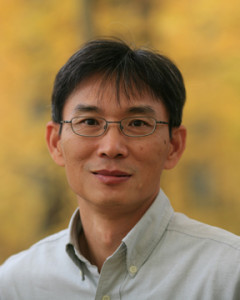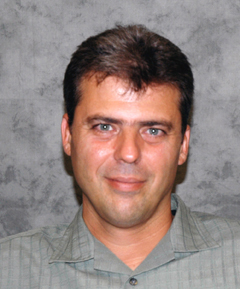WALNUT CREEK, CA—Microbial communities drive many of the important processes on the planet and DNA sequencing is emerging as a powerful tool for shedding light on their complex dynamics. Applications abound, ranging from rendering plant biomass into biofuel, to understanding how carbon is managed in the land, sea, and atmosphere, to how these communities can be directed toward cleaning up the environment. Metagenomics, as this strategy is known, has been pioneered by researchers and collaborators of the U.S. Department of Energy (DOE) Joint Genome Institute (JGI).

DOE JGI collaborator Wen-Tso Liu of the University of Illinois at Urbana-Champaign
proposed this project for the 2006 Community Sequencing Program.
In work published in the advanced online version of the International Society for Microbial Ecology (ISME)’s Journal on August 5, an international team of scientists including DOE JGI researchers report the first metagenome analysis of a microbial community grown in an anaerobic methanogenic (methane producing) bioreactor. The microbial community is syntrophic, i.e., certain organisms live off the byproducts of others.
“This is a groundbreaking finding,” said study senior author and DOE JGI collaborator Wen-Tso Liu of the University of Illinois at Urbana-Champaign. “This research offers us a better understanding of the methanogenic syntrophy—one of the key mechanisms involved in the global carbon cycle. So far, most scientists still think a simple combination of syntrophic organisms and methanogens will make this process work. The findings from this study clearly show that both primary and secondary syntrophic interactions are needed to make the degradation of chemicals to methane stable. The finding will further improve the future research on microbial fuel cells, bioremediation of toxic chemicals and radionuclides, and biofuel production.”
The sampled anaerobic bioreactor operates at higher than normal temperatures to help degrade terephthalate (TA) wastewater that results from the production of a raw chemical used to make many plastic products. The volume of the TA-containing wastewater generated is equivalent to the amount of wastewater generated by 20 million people. Currently, while the wastewater is commonly discharged at temperatures of 50-54ºC, the treatment is done by anaerobic microorganisms that thrive at moderate temperatures of 35-37ºC.
“High carbon concentration containing wastewater should be treated to a certain level by regulation for both domestic wastewater and for industrial wastewater,” Liu said. “Even though TA is not a ‘toxic’ chemical in the wastewater, other compounds like benzoate, methylbenzoate, and unknown and possible toxic chemicals are also present at high concentrations. Thus, TA-containing wastewater must be treated biologically.”
Microbes are integral to wastewater treatment processes, and more than 100 TA-degrading facilities worldwide rely on syntrophic microbial communities of bacteria and archaea to help break down the organic matter while the methanogens remove the hydrogen released to allow the degradation process to continue.
“In anaerobic conditions this is energetically unfavorable,” explained DOE JGI research scientist and study first author Thanos Lykidis. “Only in the presence of methanogens can this process proceed and that’s why in these communities you have bacteria and archaea in very close proximity.”
To better understand the syntrophic processes involved, Lykidis and his colleagues studied a thermophilic TA-degrading community in a lab-scale bioreactor originally developed by Liu when he was still in Singapore. Sequencing the metagenome of the TA-degrading bioreactor was part of the DOE JGI’s 2006 Community Sequencing Program, which provides the scientific community at large with access to high-throughput sequencing for projects of relevance to DOE missions. Lykidis noted that the bioreactor analysis offers researchers a picture of all the populations that participate in the processes and provides a model to explain the presence of the various bacterial populations.

Thanos Lykidis, DOE JGI research scientist and first author
of the paper on terephthalate-degrading syntrophic communities.
“The whole process is more complicated than just having two populations,” he said. “It reveals there are additional players in this phenomenon besides hydrogen-producing bacteria and hydrogen-consuming methanogens.”
Yoichi Kamagata, Director of the Bioproduction Research Institute at the National Institute of Advanced Industrial Science and Technology of Japan (AIST), noted that the syntrophic bacterial community “is not ‘useful’ but indispensable in anaerobic environments. Dr. Liu’s paper strongly indicates that terephathlate-degrading community also involves interspecies hydrogen transfer,” he said. “His paper has shed new light on the degradation mechanism based on a comprehensive metagenomic approach. This is the most important and significant point of the paper.”
According to Liu, more than 100 treatment facilities around the world discharge at least 20 billion gallons of TA-containing wastewater annually. “The process is already running at mesophilic temperatures but people are pushing to run it at higher temperatures of, say, 50-55ºC because then they increase the degradation rate,” he said. “It’ll be better because once you have a better degradation rate you don’t have to operate such a big facility. This is one advantage. Since water is coming out at around 50ºC, if we can have another microbial community that grows at 45-50ºC and do the same job at the same degradation rate, why not do that? That’s what this paper is about. It clearly demonstrates you can run anaerobic process under this temperature region.”
Liu added that a TA-degrading bioreactor that could work at higher than normal temperatures could be useful in reducing the footprint of TA-degrading wastewater treatment plants, as well as in developing other bioreactors that can break down other organic compounds.
Dr. Kamagata also noted that the research on anaerobic degradation could benefit not just environmental engineering companies interested in cleaning up organic contaminants but the oil, chemical and pharmaceutical industries as well. “Surprisingly, despite the long history of anaerobic methane fermenting process studies, the pathways and biochemistry of degradation of simple chemicals such as hydrocarbons and phenolic compounds are not known at all, let alone more complex chemicals such as PAH (polycyclic aromatic hydrocarbon), lignin, or crude oil,” he said. “From this point of view, there are a number of industries who would be interested in knowing more, and taking advantage of the knowledge on anaerobic degradation of chemicals.”
Today, DOE JGI is involved in more than one-third of worldwide metagenomic sequencing projects, from terrestrial and aquatic to host-associated environments as they relate to the DOE’s core interests.
Other authors on the paper include DOE JGI’s Susannah Tringe, Alex Copeland, Nikos Kyrpides and Phil Hugenholtz, now director of the Ecogenomics Center at the University of Queensland (Australia). Other collaborating institutions are the National University of Singapore (Singapore) and the Max-Planck Institute for Informatics (Germany).
The U.S. Department of Energy Joint Genome Institute, supported by DOE’s Office of Science, is committed to advancing genomics in support of DOE missions related to clean energy generation and environmental characterization and cleanup. DOE JGI, headquartered in Walnut Creek, Calif., provides integrated high-throughput sequencing and computational analysis that enable systems-based scientific approaches to these challenges. Follow DOE JGI on Twitter and Facebook.